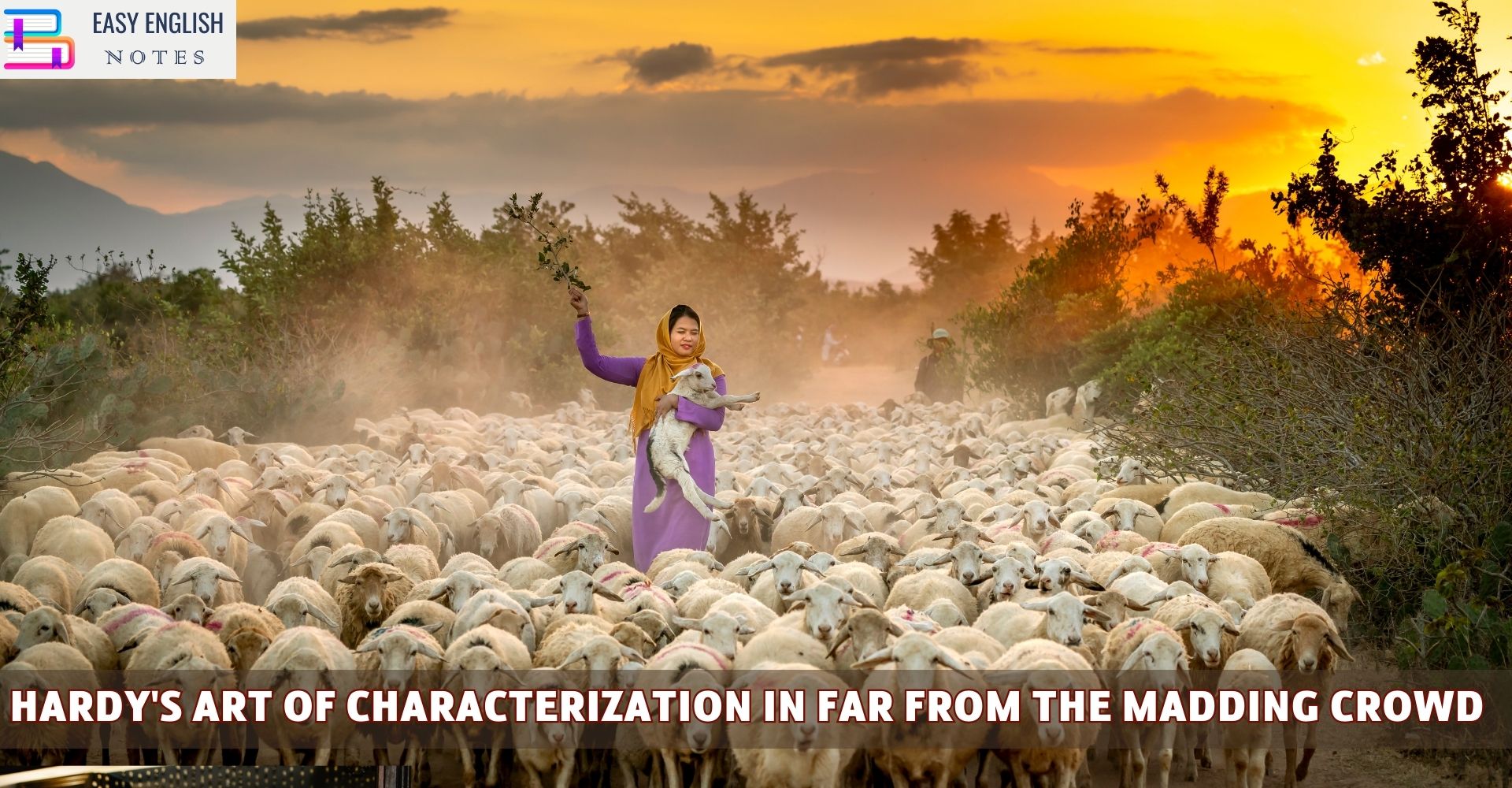Thomas Hardy, renowned for his mastery of character development, demonstrates his exceptional art of characterization in “Far From the Madding Crowd.” Through vivid and multifaceted characters, Hardy brings his pastoral novel to life. Here, we explore his techniques and delve into key characters from the novel.
Thomas Hardy is a master of the art of characterisation. He gives us characters that are creatures of flesh and blood. Most of his characters are real and living. They have three dimensions rather than two. That is to say, they are round rather than flat. Many of Hardy’s characters are both memorable and impressive.
One of Hardy’s distinctive traits is his ability to create psychologically complex characters. In “Far From the Madding Crowd,” this is evident in the protagonist, Bathsheba Everdene. Bathsheba is a headstrong and independent woman whose complexities, desires, and vulnerabilities are explored in depth. Her evolution from a confident young woman to a more mature and self-aware individual is a testament to Hardy’s psychological insight.
Throughout the novel, Hardy employs character development to showcase the growth, maturation, or deterioration of his characters. Bathsheba’s transformation from a capricious young woman to a more responsible and empathetic individual is a prime example. Her experiences, choices, and interactions with other characters shape her development.
Some of his immortal male and female characters are Angel Clare and Tess (in Tess of the D’Urbervilles); Clym Yeobright and Eustacia Vye (in The Return of the Native): Gabriel Oak, Bathsheba Everdene and Sergeant Troy (in Far From the Madding Crowd) and Henchard (in The Mayor of Casterbridge).
Most of his characters belong to Wessex, the south-west countries of England. “They are rooted like trees in their environments”. It is difficult for the mind to separate them from their native Wessex.
A large number of these characters are typical country men – peasants..shepherds, dairy-maids, grass-cutters, cottagers and petty farmers.
Thus in Far From the Madding Crowd, Oak is a skilful shepherd,.Boldwood is a prosperous farmer, whereas Joseph Poorgrass and Jan Coggan are petty labourers.
Also Read :
- Compare Hamlet with Macbeth, Othello and other Tragedies
- “The Pardoner’s Tale” is the finest tale of Chaucer
- Prologue to Canterbury Tales – (Short Ques & Ans)
- Confessional Poetry – Definition & meaning
- Line By Line Explanation Of The Poem The Eve of St. Agnes
Hardy gives us, generally speaking, four kinds of characters. They are:
characters dominated by Passion;
characters dominated by Reason;
characters dominated by Emotion and
characters dominated by Instinct.
His typical women like Bathsheba Everdene and Eustacia Vye (the heroine of The Return of the Native) are impulsive and passionate.
Some of his male characters are also dominated by impulse. Such as Michael Henchard, the central figure in The Mayor of Casterbridge.
In Far From the Madding Crowd. Gabriel Oak is dominated by Reason. whereas Farmer Boldwood by Emotion and Passion. Sergeant Troy is an example of a character who is swayed by instinct, rather than by reason or good sense.
His male characters are generally more complex than female ones. His typical women possess three qualities, beauty, intelligence and culture. According to a critic “Hardy’s typical heroines combine modern nerves with primitive emotions. What they hunger for is not an intelligent understanding of the world, but a culture and refinement which leads to social advancement and the awareness that they are now ladies”.
According to Duffin, Hardy’s women can be placed in three groups:
(a) Full-length studies of women of a high order of personality Bathsheba Everdene, Tess and Eustacia Vye (the heroine of The Return of the Native.)
(b) Full-length studies of women of less personal significance.
(c) Women who are fully studied but are of much less importance or women who have a deep significance but are not fully drawn.
Hardy’s male characters like Sergeant Troy, Angel Clare and Michael Henchard, are complex and give rise to a great number of problems than his female characters.
Hardy has filled most of his novels with a number of delightful rustics. In Far From The Madding Crowd; we have Warren, Joseph Poorgrass, Jan Coggan, Liddy Smallbury, Mark Clark, Mathew Moon and Henery Fray.
These rustics provide the element of comic relief to the novel. They are simple-minded, superstitious, witty and talkative. Some of them, like Joseph Poorgrass, remind us of Shakespeare’s clowns and fools.
In contrast to the major characters, they strike us as happy, contented and care-free.
Conclusion: Hardy, thus, is a brilliant painter of character. It is this feature of his novels that distinguishes him from all other modern novelists..The range and variety of his characters are truly amazing and remarkable.
Thomas Hardy’s art of characterization in “Far From the Madding Crowd” is a testament to his skill as a novelist. Through psychologically rich, symbolically charged, and authentically portrayed characters, he creates a world that is both captivating and thought-provoking. The characters in this novel are more than mere conduits for the plot; they are vibrant, multifaceted individuals who resonate with readers, making “Far From the Madding Crowd” a timeless exploration of human nature and rural life.
PLEASE HELP ME TO REACH 1000 SUBSCRIBER ON MY COOKING YT CHANNEL (CLICK HERE)











